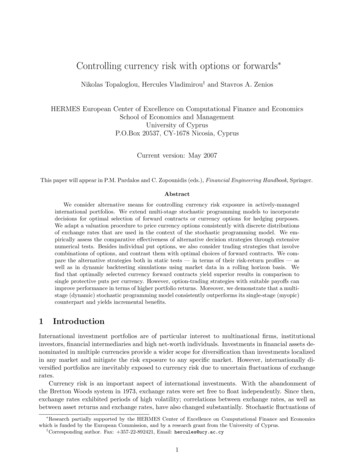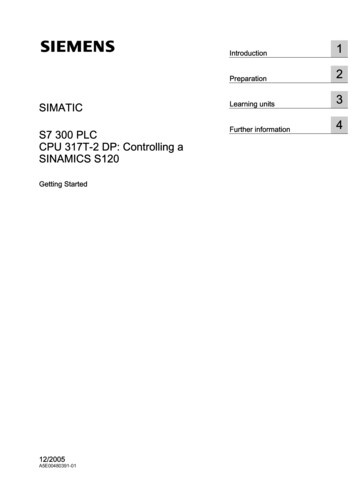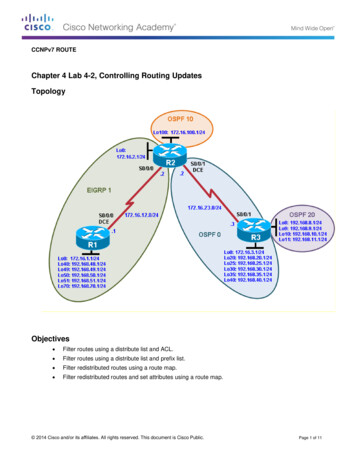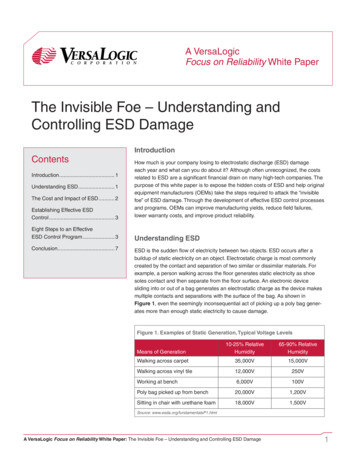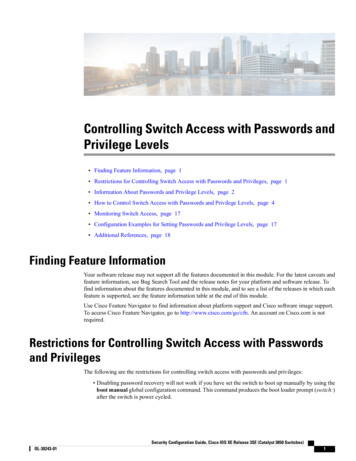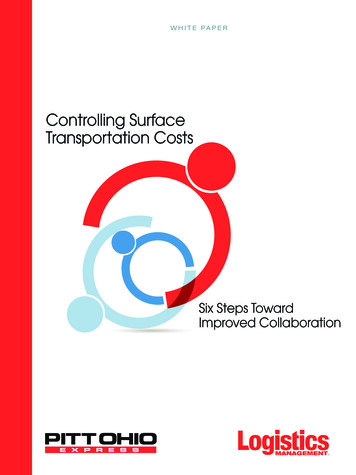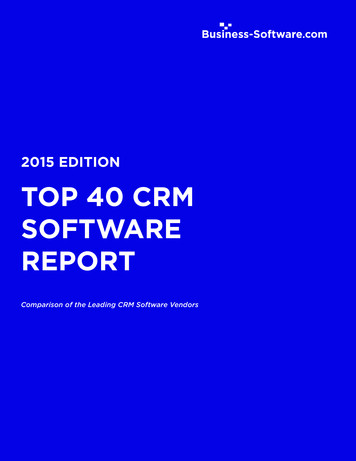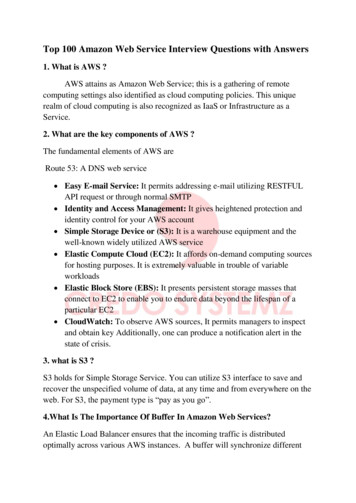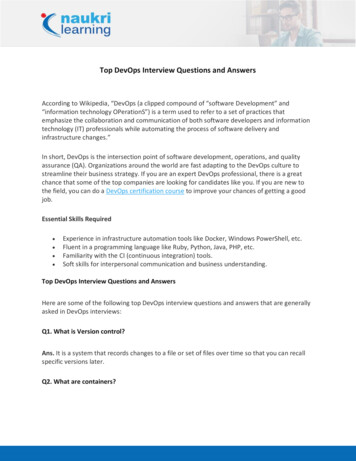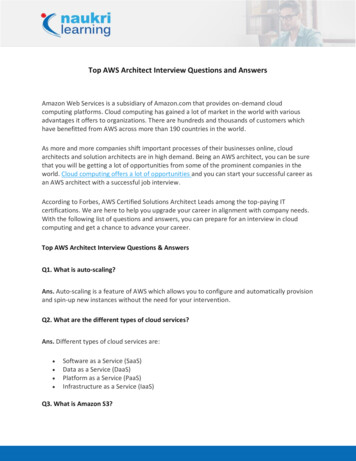
Transcription
Top SAP Controlling QuestionsWe asked our roster of SAP Controlling experts the following question: What is the topSAP Controlling question you are asked by your clients and/or co-workers? We havecompiled their responses for you here.Questions include:1. What is the difference between planning and budgeting in SAPControlling?2. Simple Finance, Central Finance, S/4HANA Finance, Universal Journal,Simplified Financials, Smart Business, S-Fin, Side-Car, etc. What is what?3. How do I troubleshoot product costing error messages?4. Why are there profit center accounting sections in the SAP menustructure under both FI-GL and in CO under Profit Center Accounting. Arethey the same thing, or are they different?5. POB, VC, SSP huh? What do these acronyms have to do with SAP andControlling?6. Why are there differences between CO-PA and G/L?7. What are some SAP Controlling best practices to manage fleet costs?8. What is Work in Process (WIP?9. Why standard costing - what's the advantage?To learn more from all of the experts who answered the top SAP Controlling questions, attendthe Controlling 2016 Conference September 12th – 15th, 2016 at the Westin San Diego Hotel,San Diego, CA.Learn more about the Controlling 2016 Conference: http://controlling.erpcorp.com/Copyright ERPCorp 2016/Controlling 2016http://controlling.erpcorp.com/
1. What is the difference between planning and budgeting in SAPControlling?Theoretically, planning is related to strategies and long term management of your resources to achieveyour business goals while budgeting is meant for managing and monitoring how you spend your funds inyour day-to-day transactions. However, in SAP there are some differences between budgeting andplanning that you should be aware of and we can put them under three main headings:Level of details: When you record your planning in SAP, you are able to detail your planning as muchas you can. You can plan by cost element, activity type, resource, etc. You can also plan using quantitiesand capacities. On the other side, budgeting uses one lump sum amount per object.Availability control: Availability control is the function you use to make the system checks theavailable amount to be spent on a specific object and issue warning or error messages at some levels ofspending. Availability control can be activated using budgeting and can’t be activated for planning. Thismeans that you are just able to report on the variances occurred between planning and actualexpenditures, but you cannot automatically stop spending over the planned amounts which is possibleonly using budgeting.Allowed controlling objects: Planning can be done on all types of controlling objects, so you canplan on cost centers, profit centers, internal orders, WBS elements while budgeting is applicable only onthe temporary or the project-like CO objects (internal orders and WBS elements). Actually, you canrecord a budget for a cost center but you can’t use availability control with it which is the main purposeof budgeting.Mohamed Elshinnawy began his career as an accountant and has worked as an SAPconsultant for more than 7 years. He has worked on several implementations in Egyptand the Middle East, in addition to global projects in cooperation with teams fromthe U.S. and Europe. He also works as an SAP trainer for IT and accountingprofessionals as well as for new graduates starting their SAP career. He has workedfor several SAP partners including IBM, his current employer.Copyright ERPCorp 2016/Controlling 2016http://controlling.erpcorp.com/
2. Simple Finance, Central Finance, S/4HANA Finance, UniversalJournal, Simplified Financials, Smart Business, S-Fin, Side-Car, etc.What is what?Sometimes I wish I worked for “One Voice”, the SAP marketing group whose job it is to come up withfancy names like Fiori or Lumira, to make up 3-letter acronyms (and even including numbers like C4Cand C4A), and to keep changing names every 3 months to keep you on your toes!From R/3 to S/4As you are probably aware by now, SAP has started a complete redesign of its enterprise software,leveraging its new high-performance in-memory database called HANA (if that’s news to you, you shoulddefinitely attend the annual Controlling Conference).Transitioning from R/3 to S/4HANA FinanceSAP Business Suite on AnyDBSAP Business Suite powered by SAP HANAhttp://help.sap.com/saphelp 6fe/content.htmSAP Simple Finance Add-On for SAP Business Suite powered by SAP HANA(aka Simple Finance 1.0)http://help.sap.com/sfin100Copyright ERPCorp 2016/Controlling 2016http://controlling.erpcorp.com/
SAP S/4HANA Finance(aka Simple Finance 2.0)http://help.sap.com/sfin200Let’s assume that your company is running any version of the “SAP Business Suite” (R/3) with thetraditional Finance (FI) and Controlling (CO) modules on any of the major databases like Oracle,Microsoft or IBM.The first move would be to migrate to SAP’s HANA database. At that point, your company would berunning the “SAP Business Suite powered by SAP HANA”. This is mostly a technical upgrade. Not toundermine the complexity of the work that has to happen there, but since the programming has barelychanged, the impact on Finance and Controlling will be limited, except for an expected faster runtimewhile executing reports from your transactional system.Once the database is migrated, the coding can be optimized to leverage the power of HANA. This is doneby installing the “SAP Simple Finance Add-On for SAP Business Suite powered by SAP HANA”. Yes, theSSFAOfSBSpbSH. Thanks, One Voice! No wonder people started calling it “Simple Finance”, or S-Fin forshorts. For a little while in 2014, the term Simplified Financials or Smart Financials were also used, buthave been discarded.During the installation of this add-on, new coding wax activated. Especially, lots of old aggregationstables were replaced with views that perform much faster. In addition, some FI and CO tables weremerged in the so-called Universal Journal. This is a key feature of Simple Finance that largely reduces thenumber of documents and simplifies the reconciliation between FI and CO.The next generation of SAP enterprise software is called S/4HANA. It combines: the high-performance HANA database, the redesigned Data Model like the Universal Journal, a state-of-the-art user interface called SAP Fiori, a new configuration methodology called SAP Activate, more deployment options (more on this later).Until now, in our upgrade steps, we have changed the database and replaced some coding and tables inthe Finance and Controlling modules. However, the user interface is still the same: either your good oldSAP GUI or the more recent (but very similar) NetWeaver Business Client. With SAP Fiori, users willexperience a completely new way of working. For the roles related to Finance and Controlling, severalapplications have been grouped under an umbrella called “Smart Business Cockpits”.Copyright ERPCorp 2016/Controlling 2016http://controlling.erpcorp.com/
SAP Smart Business. Source: SAPIn S/4HANA, the combination of the upgraded data model and new user interface for Finance andControlling is called “S/4HANA Finance”. In the upcoming years, the development teams will keepredesigning other modules and you will soon see “S/4HANA Logistics” or “S/4HANA Human Resources”or “S/4HANA Supply Chain”.New Deployment OptionsSAP HANA and S/4HANA offer new deployment options. Beyond the traditional On-Premise defaultscenario, the Business Suite can now also easily be deployed in the cloud (public or private) or in hybridcombination.Copyright ERPCorp 2016/Controlling 2016http://controlling.erpcorp.com/
S/4HANA Deployment Options. Source: SAPIn addition to deployment options for the Business Suite, HANA can be used in news ways to benefitsfrom innovations with no or little disruption.In the first such application, “COPA Accelerator powered by SAP HANA”, an SAP HANA database isdeployed in parallel to the existing Business Suite running on atraditional DB. Data is replicated in real time from theTraditional DB to the HANA instance. Reports andTransactions are running directly from the HANA database inorder to gain performance without the need to train the endusers. This scenario has the benefit that in case the HANAdatabase need to be stopped, the Business Suite willautomatically revert back to the traditional DB.Another implementation scenario is the Full Side-Car. Inthis case, an S/4HANA instance is deployed in parallelto the Business Suite and some or all of the data isreplicated between the traditional database and theHANA database. Users can still run their transactions inCOPA Accelerator. Source: SAPCopyright ERPCorp 2016/Controlling 2016http://controlling.erpcorp.com/S/4HANA Side Car
the current ERP system and analyze results and reports in the new SAP Fiori interface. This solutionenables companies to evaluate S/4HANA in a safe environment, including sizing, on-premise vs. cloud,new user interface, etc. This scenario is highly recommended in proof-of-concept projects.Last but not least, S/4HANA can be used as a CentralFinance system. Lots of companies running multipleERP instances—SAP and non-SAP. They simply cannoteasily upgrade, let alone merge all these instances andbenefit from SAP’s latest innovation. Creating a realtime, granular, and global view of the organization is acontinuous challenge.An alternative to this situation is to setup a newS/4HANA instance or to upgrade one of the currentones to S/4HANA. From there, all other instances canbe connected to the Central Finance module.Transactions performed in the local instances will bereplicated into the central one, thus enabling a singleversion of the truth that can be consumed through thelatest user interface and with great performance. Allwithout disrupting local operations.S/4HANA as Central FinanceConclusionYes, it’s hard to keep up with SAP’s rapid innovation cycle and the marketing vernacular. Hence,continuous education and networking are becoming critical. Do not hesitate to reach out with yourquestions, comments, and needs for clarification.Julien Delvat is a Principal Consultant for SAP S/4HANA at Bluefin Solutions. He has morethan 10 years of experience in SAP Controlling and got his start as a developer for COmaintenance and development at SAP Labs France. Julien is a frequent speaker at SAPconferences and is the Chair of the ASUG Managerial Accounting Special Interest Group.He lives in Miami, FL with his wife and two children.Copyright ERPCorp 2016/Controlling 2016http://controlling.erpcorp.com/
3. How do I troubleshoot product costing error messages?I am often asked how to troubleshoot common error messages encountered during costing inSAP Product Cost Planning (component CO-PC-PCP).Product costs are impacted by multiple factors including system design, accounting policies,business requirement, costing configuration and master data setup. It is therefore not possibleto visualize and list out all possible errors during costing. Let’s take a look at the most frequentcosting errors. First though, we need to take a look at an overview of cost estimates and costingrun is provided as a background.Cost EstimateA cost estimate is the planned cost of a material or a production cost carrier. It utilizes the Billof Material (BoM) and routing / recipe to arrive at the planned cost. This planned cost can betransferred to the material master, utilized in product costing to valuate the material.Cost estimates are created using transaction CK11N (Create Material Cost Estimate withQuantity Structure). Once reviewed and validated for accuracy, cost estimates are markedReleased using transaction CK24 (Price Update: Mark / Release Standard Price). Certain costestimates can be created only for the purpose of analysis but need not be released as astandard cost estimate in the material master.Costing RunMass costing is carried out using transaction CK40N (Edit Costing Run). The costing run enablescosting of multiple materials at the same time. A costing run reproduces the entire process ofcosting a product with a Bill of Material (BoM). Mainly suited to carry our costing for a large setof data, they can be executed in background mode for large volumes of materials.Costing results can be used to mark and release several standard cost estimates at once. Markand release steps are built into the CK40N mass costing run (unlike CK11N individual costingwhere mark and release are performed using another transaction, CK24).Steps in Costing RunCosting run involves following steps: Selection – materials are selected for the given plant / co code / material / material typerestriction Structure explosion – bills of materials, routing / recipes are exploded, costing levels aredeterminedCopyright ERPCorp 2016/Controlling 2016http://controlling.erpcorp.com/
Costing – materials in lowest level are costed first (e.g. raw materials), moving to nexthigher level Analysis – comparison with material master, expected revaluation are calculated Marking – costing result is updated as future planned price in material master Release – costing result is updated as current planned price in material masterA screenshot of an example costing run is provided in Figure 1. The costing step has two errorsand the costing log needs to be reviewed to analyze the errors.Figure 1: CK40N Costing Run example with error log highlighted at costing stepCopyright ERPCorp 2016/Controlling 2016http://controlling.erpcorp.com/
There could be a situation in a typical SAP implementation project where master data has beensetup for the first time. A wide open costing run of all materials may result into a numerouserrors and can make the error analysis and troubleshooting a bit cumbersome. In such ascenario, costing by costing levels is useful in segregating errors by costing level.Drivers for CostingProduct costing is the valuation of material components and activities on
Level of details: When you record your planning in SAP, you are able to detail your planning as much as you can. You can plan by cost element, activity type, resource, etc. You can also plan using quantities and capacities. On the other side, budgeting uses one lump sum amount per object. Availability control: Availability control is the .
